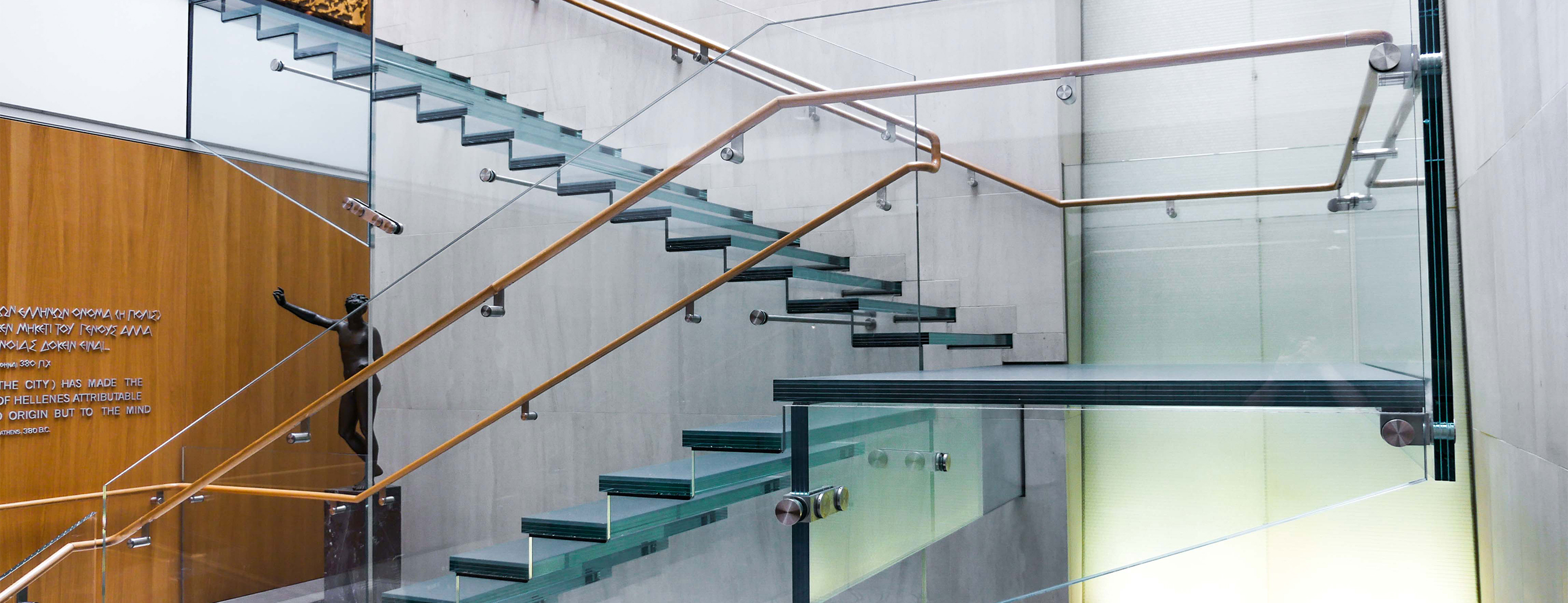Cantilevered with a 2500-lb glass wall, and perfectly-aligned smooth edges, this all-glass staircase is an engineering marvel of standing tension.

Located below grade in the Olympic Tower on New York City’s Fifth Avenue, the staircase connects visitors to the Onassis Cultural Center. The challenge was to design and fabricate a minimalist staircase with strict structural requirements and loading that would be strong, safe, and stable. As the glass fabricator for this unique project, we collaborated with engineers Michael Ludvik Engineering and Eckersley O’Callaghan, and glazier Mistral Architectural Metal & Glass. We take a look at the success of the project and three reasons why this fabrication feat is considered world class.
EDGEWORK & ALIGNMENT
These stairs required a resilient but firm edge, polished and trimmed with accuracy, precision, and clarity. AGNORA worked extensively on internal research and development to enhance the requisite skills, tools, and materials with new, proprietary techniques to trim and polish the vertical and horizontal edges of the glass and interlayer. This resulted in heat-treated laminates with edgework that was perfectly aligned, creating the ultimate smooth surface, without the post-laminate polish. While some PVB interlayers can be yellow in tone, we chose SGP interlayers, which created an edge that was water-clear, a critical component to the aesthetic of the staircase. With custom shapes and angles, the heat-treated laminates were run through CNC processes that resulted in the most precise alignment of the holes and four-ply laminates, accurate to a world class level of glass fabrication.
LAMINATION FOR SAFETY & LOAD-BEARING
Cantilevered, the middle landing is the impressive, piece de resistance. The center staircase wall and landing balustrades are high-stress areas therefore the vertical stringers required a unique fabrication feat of 4-ply, SGP structural laminate. One end of the tabbed treads was supported by what we coined ‘mail box slots’ in the middle wall. The other end of the treads was supported by a 2-ply sawtooth stringer, laminated to the face of another 2 ply.
The thickness and weight of the glass was also critical. All vertical load-bearing parts of the staircase were comprised of either 3 or 4-ply, heat-treated, 12mm glass. All horizontal components were annealed and the massive vertical center wall was a 4-ply laminate. Weighing 2500lbs, this 115” x 175” central wall was the largest and most complex section of the staircase. We used Optiwhite, heat-treated, low iron glass, and two layers of SGP interlayer for this wall.
PERFORMANCE & TESTING
In order to provide greater resistance to thermal, mechanical stresses and achieve specific break patterns for safety glazing, the glass was subjected to a heat-treating process. During the heat treatment process, the glass was analyzed for localized distortion. By scanning the glass before final assembly, we ensured that we met the desired quality needed for the staircase.
Michael Ludvik Engineering and Eckersley O’Callaghan performed a number of critical structural engineering calculations on the glass staircase, including tests to verify if the resistance of the annealed treads met specific ASTM requirements. The staircase also had to meet New York City building performance code regulations, which provided specifications on aspects such as the height of the glass balustrades and the distance between handrails and treads.
Looking for more inspiration? Check out our other projects here.
About the Onassis Cultural Center
The Onassis Cultural Center NY explores Hellenic culture, from antiquity to today, through a rich and diverse program of exhibitions, events and online engagement. The newly renovated creative space in midtown Manhattan, designed by Perkins Eastman, presents a season of events where audiences can engage with art, ideas and culture.






